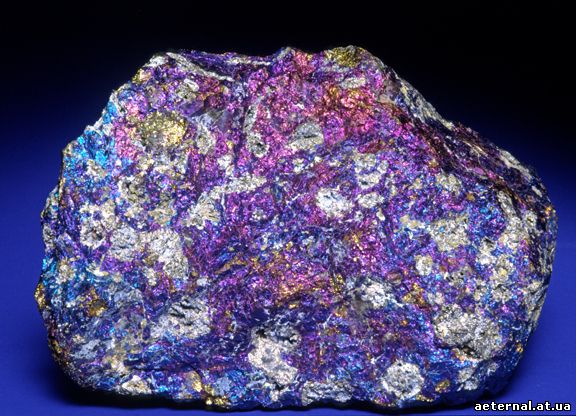
Among the iron and copper sulfides bornite is easily recognized by its bright blue tint and low hardness. The presence of bornite in copper ores, indicating their high quality.
Bornite is often called a variegated copper pyrites. Samples and dazzle you with a rainbow! However, is dominated by blue and purple hues. Iriziruyuschaya film on the surface of a mineral called tarnish. Meanwhile, the true color of bornite is not blue. On fresh fracture the mineral copper-colored in red or bronze-brown color.
MASSIVE MINERAL
The crystals are rare bornite. As a rule, cubes, octahedra, and rhombic dodecahedron with the imperfect, distorted faces. Sometimes minerals form twins, but look at them with the naked eye is not easy. It is much more widespread aggregates of bornite. It forms a solid or granular masses, and the crust on the other sulfides. Formed in the hydrothermal deposits of endogenous or exogenous zones of secondary sulfide enrichment.
SURROUNDED sulfides
Bornite constant companions - other sulfides and sulfosalts of copper and iron: chalcopyrite, chalcocite, covellite, tetrahedrite, pyrite. Most of bornite intergrowths with chalcopyrite - the result of decomposition of the solid solution. In bornite often find the inclusion of other minerals enargite, cubanite, cobaltite. Bornite is easily confused with pyrrhotite, which, however, higher hardness.
Bornite was opened in 1845 by William Haydingerom and named in honor of the mineralogist Ignaz von Born {1742-1791). In addition to his scientific career, Born is known for friendships with many famous people of his time. In particular, with Mozart, he shared passion for Freemasonry.
Where found bornite
Large deposits have bornite in the U.S. (Connecticut, Montana, Colorado and Arizona) and Chile (Atacama, Antofagasta). In Russia, bornite disseminated in the southern Urals and Trans-Baikal, in Kazakhstan - in copper ores Dzhezkazgan.
Handsome and without crystals
Bornite ore - an important source of copper. Fine-grained bornite widely distributed and prized as a raw material with a high content of non-ferrous metal. While well-formed crystals of bornite.
In the disseminated ores bornite bornite occurs with other sulfides of copper-, chalcopyrite, chalcocite, covellite, digenite. In addition to high concentrations of copper, the main component produced in these ores are generally high content of other precious metals, particularly gold, silver, gallium, germanium. These elements are isomorphic to the part of the sulfides crystallize in either form its own minerals, forming a fine disseminations.
ESSENTIAL COPPER
Extracted from the bornite copper - metal, familiar to any student.
Its scope is truly wide. This power cables and wires in the electrical, water and heating pipes in municipal services. Copper is part of the most common alloys - bronze and brass. By the way, the lion's share goes to the manufacture of brass shell casings. In the jewelry industry without copper, too, can not do: it increases the strength of an admixture of gold.
In bornite EDGE
The best crystals of bornite occur from old copper deposits of Cornwall in southwest England.
Born in Collections
The crystals of bornite prized by collectors for their rarity. The best collection samples mined in Cornwall (England) and HJK (Kazakhstan), as well as in the field Blade (Morocco). The easiest way to complete your collection grained bornite with a stunning bright tarnish. These samples are much higher among the collection of material put up for sale.
Moody Stone
Jewelers have repeatedly tried to cut bornite cabochon and beads. The result exceeded all expectations, but the articles were very short-lived. Attempts to treat the stone with a special compound, increase the wear resistance of bornite, were unsuccessful.
Did you know that ...
Bornite is often called "peacock ore" because of the characteristic blue-purple tint, which is similar to painting colorful peacock feathers with a blue tint. This iriziruyuschaya pestrookrashennaya film is formed by a weak surface oxidation of the mineral. In addition to bornite, it is characteristic of chalcopyrite, covellite, limonite, marcasite. Samples of minerals with tarnish, change color from golden yellow to pink and green red, blue and purple, highly prized by collectors. swarovsky
Related Topics:
|



